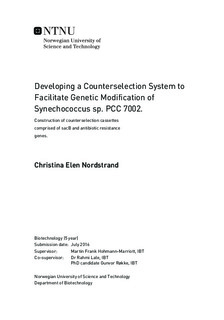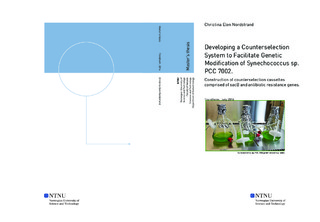| dc.description.abstract | Cyanobacteria have recently gained a great deal of attention as hosts for metabolic engineering, due to their innate ability to convert CO2 and sunlight into a variety of chemical products. Cyanobacteria are of special interest as hosts for production of biofuels, which are important for combating global climate change. Compared to eukaryotic algae and plants, many cyanobacteria are easier to genetically engineer, and can grow faster. Furthermore, they are capable of growing under a wide variety of temperatures, light condition and salinities, and cultivation of the bacteria does not compete with the food industry for arable land. Cyanobacterial model strains have already been engineered to produce a wide variety of products. However, the production rate is slow, and the price of commodity goods generated by cyanobacteria is too high to make the production economically competitive. More research and synthetic biology tools are needed to overcome these limitations (Liu et al., 2011, Berla et al., 2013, Taton et al., 2014).
This thesis represents a small contribution to the goal of giving Synechococcus sp. strain PCC 7002 and other cyanobacteria a toolbox of genetic parts, that can be utilized to establish cyanobacteria as successful biotechnological platforms for the production of renewable chemicals and biofuels. The aim of the study was to construct a genetic system that facilitates the genetic modification of wild-type Synechococcus by counterselection. The sacB gene from Bacillus subtilis was chosen as the counterselectable marker utilized for this purpose. The gene confers conditional lethality to Gram-negative bacteria harboring the gene, where growth in the presence of 5% sucrose leads to death of the host cells (Gay et al., 1985, Pelicic et al., 1996, Viola et al., 2014).
Various counterselection plasmids were constructed and cloned into Escherichia coli DH5α, each containing a counterselection cassette comprised of sacB and one or two antibiotic resistance genes, i.e. kanamycin resistance (kanr) and chloramphenicol resistance (Tn9cat). The cassettes were surrounded by synthesized sequences identical to the A0160, A0935 or A2843 neutral integration sites within the genome of wild-type Synechococcus. The flanking sequences were utilized to facilitate homologous recombination, and thereby incorporation of the cassettes within the neutral sites of the Synechococcus genome. One of the constructed plasmids, pA0160-KanR-sacB, was investigated by sequencing. The results verified the presence of sacB and the kanr gene, and confirmed that the genes were incorporated in the expected place and in the right orientation within the constructed plasmids.
Several successful transformations were performed utilizing this system. However, verification of cassette functionality proved to be problematic, as sacB-mediated counterselection was observed to be NaCl-sensitive. In E. coli host cells this problem could be circumvented by excluding NaCl from the growth plates. However, for Synechococcus host cells, the problem was more difficult to circumvent. NaCl was removed from the growth media, but sodium and chloride were still present as part of other media constituents. At this point, sacB-mediated counterselection could not be achieved within Synechococcus host cells. While the system shows great promise, appropriate selection conditions have to be established before it can be fully implemented in Synechococcus. | |

